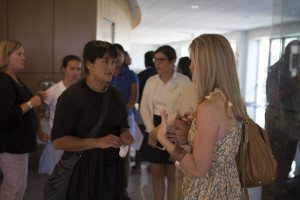Olivia Clipperman ’19, Zexi Hao ’19: “The Way They See It, The Way They Tell It” is an art gallery on display in the Episcopal Academy Crawford Campus Center until September 30th, featuring pieces of art that tell very distinctive stories. The gallery showcases seven Pennsylvanian artists, all of whom produce narrative-based works. Susan Coote, the organizer of the show, said, “I looked for local artists that would describe their work as dealing with narrative and storytelling.” There are seven such artists being featured in the gallery now, including Samantha Simpson and Colette Fu.

Photo courtesy of Jenna Cooley ’16
Simpson has two pieces in the show that make, in her words, an “argument about art.” They both depict a battling otter and swan in the foreground and have backgrounds full of detail. “I started thinking about how we think about beauty, and how we like our beauty to also be good,” she says, on her inspiration for these paintings. “We like minimalism, we like abstraction, we like color, but too much color, we say, is tacky. I’m like, ‘no’, too much color is great, and feminine is great.” Simpson’s works in the gallery are done in mixed media. She uses micron pens, markers, and an archival watercolor. “It’s based on the colors from Japanese prints,” she explained, describing the vibrant palette of the pieces.
Simpson continued by explaining the symbolism behind one of the major components of both paintings, the swan. “The idea is that the swan is like that uncomfortable kind of beauty, because swans are sort of a tacky symbol in art and they’re just beautiful. It’s not a sophisticated art thing to do, to make a swan, because everybody loves swans and everybody thinks they’re beautiful,” she notes. The otter represents the other half of her argument. In one of these paintings, the otter is winning the battle with the swan wrapped around its shoulders in a cloak-like fashion. In the other, the swan is winning and the otter is pinned beneath its feet.
Fu also has three of her works on display in the gallery. These are pop-ups made of many photographs layered into one, depicting the festivals of the minority groups of Southwest China, especially the Yi and the Wa groups. When asked how she received her inspiration, Fu said, “I spent a year in Southwest China, on a Fulbright scholarship. My project was to photograph the different minorities of Yunnan province.” She pieced together many photos to create one whole image that recreated the scenes she saw during her visit to China. Describing her piece called Rub You Black, Fu explained “Here is a festival of the Wa people. It’s a mud festival…the mud has blessing properties. If it’s put on a kid, it gives them good luck. If it’s put on an old person, it gives them longevity. If it’s put on a woman, it makes them beautiful.” In Yi Tiger Festival, Fu depicted “a tiger worshipping ceremony…Annually, the Yi people get together…They worship the tiger, so this is to honor the tiger. They’re supposedly dressed as tigers…, and then they dance and they recreate scenarios relating to agriculture, and the way they lived.” The last piece by Fu is called Yi Costume Festival. Fu said, “The Yi women get together and show off their embroidery. It used to be a beauty contest, but now it’s just a gathering. Their hat is in the shape of a rooster comb because they have a fairytalej that supposedly an evil king was after a woman from this village, and she learned that if she called out like a rooster, the evil king would get scared.”
Seeing both Simpson and Fu discuss their work with students at the lunch reception on September 16th, Coote made sure to mention that, “I always like having artists in the gallery who are teachers, and most of these artists also teach.”